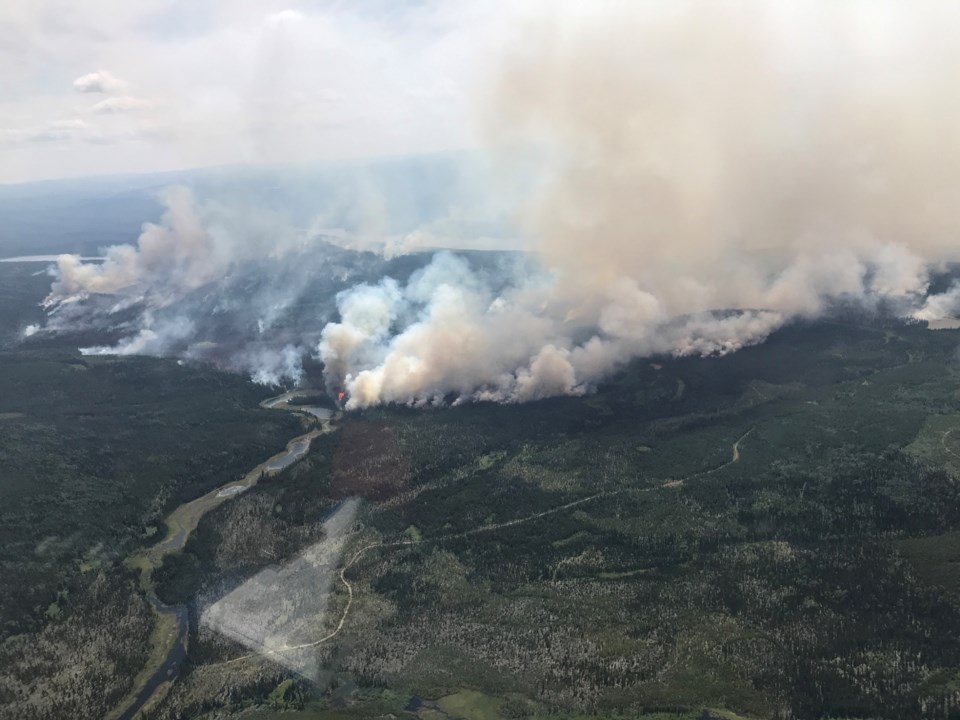Overnight rain provided some relief for forest fire fighters battling blazes southwest and northeast of Prince George Saturday but the heavy thundershowers were not nearly enough to extinguish those wildfires, one of which has grown to more than 9,000 hectares.
The Cutoff Creek fire, about 80 kilometres south of Vanderhoof, grew to 9,335 ha Saturday, increasing in size from 8,930 ha Friday afternoon. That was the fire producing most of the smoke that drifted over the city earlier this week, obscuring visibility and prompting a health warning from Environment Canada.
The BC Wildfire Service has sent 53 firefighters, four helicopters and 18 pieces of heavy equipment to the interface fire, focusing on the southern extremity to protect infrastructure and/or buildings in the area.
The overnight thunderstorm that started around midnight and continued for several hours early Saturday morning produced frequent lightning flashes and heavy rain, giving Prince George and the surrounding area its first significant rainfall since June 5, when 15.4 millimetres of rain fell on the city. The good news is the lightning that came with those heavy showers and strong wind gusts has not yet resulted in new fires detected by the Prince George Fire Centre.
“It was so nice to come put this morning and see a bit of blue sky,” said Sharon Nickle, a communications specialist with the Prince George Fire Centre. “(The rain) obviously was enough that we haven’t discovered, as of yet, any lightning starts. We don’t really have a lot of action in the Prince George zone. I haven’t talked to my counterparts in the northeast but any rain is a welcome thing.
“Where we had the lightning there was also precipitation with that and we did have quite a bit of (lightning) activity over our zone but we also had some of the most rain along with it. The same thing happened in the northeast corner of our fire centre. I’m not seeing on my dashboard any new starts.”
The Chilako fire, about 60 km south of Fraser Lake, remained unchanged overnight at about 1,451 ha. There are 55 fire fighters, four helicopters with buckets and 24 pieces pf heavy equipment involved in fighting that fire.
The Tentfire Creek northeast of Prince George near Tumbler Ridge grew slightly overnight to about 1,00 ha, from 915 ha on Friday. The province’s efforts to extinguish that fire involve 24 firefighters, six helicopters and 13 pieces of heavy equipment. One new fire, two ha in size as of Saturday afternoon,, was reported near Grizzly Lake, 60 km southeast of Vanderhoof in the Finger-Tatuk Provincial Park.
No water bombers have been deployed to try to douse the fires in the Prince George area. Nickle said the planes that are available are battling more significant fires in the province.
“Unfortunately for us, it’s tough,” said Nickle. “A lot of the times when they are looking at ones that have immediate threats to life and safety that’s where we focus suppression efforts and getting as much under control as we can.”
The Regional District of Bulkley-Nechako expanded the boundaries of its evacuation warning Friday night and residents have to be ready to leave the area immediately if fire conditions worsen. The warning covers an area south of Vanderhoof that begins about 133 km from where Kenney Dam Road turns into Lakes Road, southwest to Knewstubb Lake, then east along Red Road, It follows the regional district boundary to south central part of Finger-Tatuk Provincial Park. The boundary also extends from where Kenney Dam Road turns into Lakes Road, southeast to the centre of the park..
Nickle is encouraging people to learn ways to protect their property from catching on fire and suggests readers go to the Fire Smart BC website to download a safety guide that offers tips on how to make homes more wildfire-proof.


